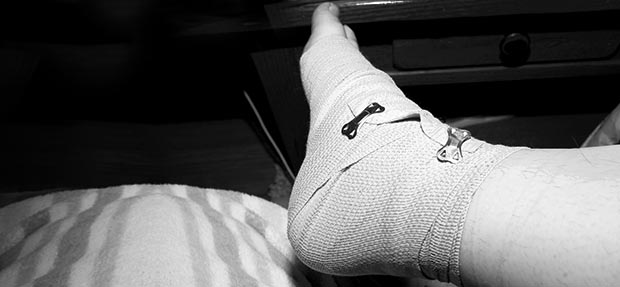
Ankle pain can be extremely common. Following on from Ask The Physiotherapy Partners: How Can Physiotherapy Help with Ankle Pain? looking at treating Achilles Tendonitis, this month will discuss how physiotherapy can help ankle sprains and strains.
A sprained ankle is one of the most common ankle injuries, but there are many different causes for this type of pain.
Sports injuries are often thought responsible for ankle pain, but you do not have be an athlete to twist your ankle. Anything from walking or uneven flooring can cause a rolled ankle, which results in an ankle sprain or strain. This type of injury can occur to anyone at any age, and affects thousands of people.
A sprained ankle occurs when your ankle ligaments are overstretched. The sprain can vary in severity from a mild ‘twisted ankle’ or ‘rolled ankle’ sprain through to more severe injuries. At the time of injury you may hear a popping or cracking sound and may spot swelling, bruising and ankle pain. You also may have trouble walking or standing depending on the severity of your ankle sprain. Crutches or walking boots may help you to mobilise throughout the day.
It is important to seek treatment when this injury has occurred as the correct post-injury rehabilitation exercises can significantly decrease the chance of reinjury. Here at The Physiotherapy Partners, the physiotherapist that you see will be an expert in assessing, diagnosing ankle sprains or strains and recommending the correct treatment for recovery. Unfortunately there is no specific time frame for recover from an ankle sprain but there is a number of things physiotherapy treatment aims to do.
The first involves injury protection, pain relief and to control inflammation. The initial treatment is therefore is to rest and to apply ice to reduce pain and swelling. A compression bandage and elevating your ankle can also reduce swelling from around your ankle. Your The Physiotherapy Partners physiotherapists will also advise other helpful tips to relieve your ankle pain. The second phase of treatment involves regaining full range of motion. Your physiotherapist will assess the amount of ankle joint motion you have, to prevent further injury to your ankle, foot or calf. You will prescribed a number of personalised exercises to best suit your needs and condition, to address your range of motion and aid muscle length and normal tissue motion.
Your physiotherapist will then guide you to restore muscle strength. It is important to regain normal muscle strength to help provide normal ankle control and function. Your strength will increase gradually by following a number of specific exercises that your The Physiotherapy Partners therapist will aid you with. The fourth stage of your treatment will help to normalise foot biomechanics, this may require consulting a foot orthotic, but your physiotherapist will explain different options, if needed.
Your balance and sense of relative position of neighbouring parts of the body, are then assessed to restore high speed, power, proprioception, and agility. To prevent re-injury your physiotherapist will guide you with customised exercises for prevention and improving sporting performance. If you play a particular sport you may require sport specific exercises to make sure you are safe and fully recovered to return your sport. Your physiotherapist will talk you through training schedule, your goals and how to best to approach your return to playing. Hopefully, The Physiotherapy Partners can help this happen as quickly and smoothly as possible.
The Physiotherapy Partners are happy to provide advice and training plains from all three of our clinics. So if you are currently suffering from ankle sprain or strain please contact us,
If you are suffering from ankle sprain or strain please get in touch. Here at The Physiotherapy Partners are happy to provide advice and training plains from all three of our clinics.
If you’ve got a question for our team, just email it to us at ask@thephysiotherapypartners.co.uk.



